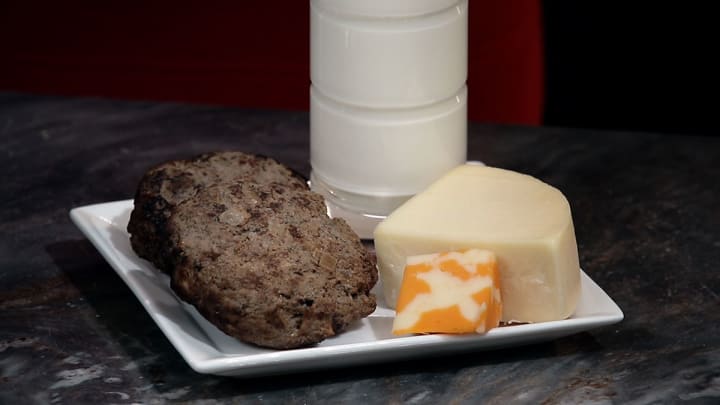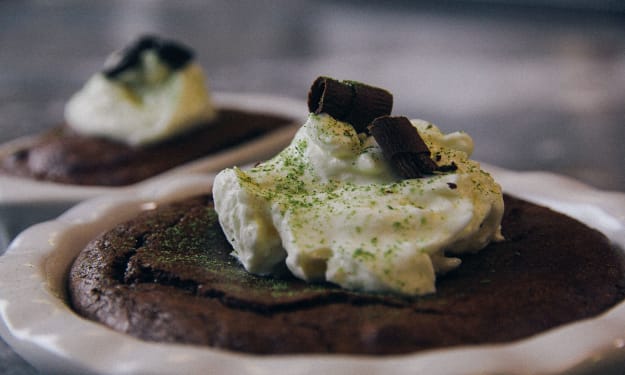How To Convert Cannabis in Fat
Learn how to convert cannabis directly in fatty foods with this 'Baked: Cooking with Mary Jean' exclusive how-to.

Converting cannabis prior to incorporating it into edibles is the crucial step in any Baked: Cooking with Mary Jean recipe. As noted in the decarboxylation tutorial, conversion is a necessary part in the process of activating cannabinoids.
Smoking and vaporizing are natural decarboxylators in their inherent nature, as decarboxylation requires time and heat. With smoking and vaporizing, heat is the instantaneous factor that knocks the carbon atom off of the THCA molecule, allowing it to become a very active THC. Usually, this process can be achieved with the help of everyone’s (maybe) favorite appliance: the oven.
However, when cooking with fat, you don’t need to decarboxylate the cannabis prior to cooking; you can do it while cooking. In order to activate the THC properly, the cannabinoids must be infused into fat, then added to the recipe. Simply put, you can place the finely ground cannabis into a simmering pan of your chosen fat (oil, butter, meat). With the assistance of heat and time, the THC binds to the fat, allowing it to become psychoactive (which it is not in raw form).
It is important not to grind up your weed, throw it in a batch of cookies, and assume you’ll activate its psychoactive effects. This is the equivalent to eating grass. Nothing will happen! Decarboxylation is key. It also makes you sound scientific when you say it out loud to your friends.
Cooking Cannabis and Fat

You do not need to decarboxylate your cannabis ahead of time when fat is included in the recipe. But, this does not mean that you need to be careless in making sure your cannabinoids are completely active. Some of the most common fats to cook with are:
Some oils are better to cook––and convert cannabis––with than others. For example, peanut oil and coconut oil are better to use in cannabis recipes than olive oil. Peanut oil and coconut oil respond well to higher temperatures when sautéing and cooking. Olive oil is not ideal to convert cannabis with, as it does not sit well at higher temperatures, prohibiting the cannabis from having a successful conversion. Remember, heat and time are our best friends when converting cannabis. If this process is not completed, or executed poorly, the cannabinoids will not be active and you will not feel or experience any of the psychoactive desirable effects.
Converting in Butter

Butter is a staple in many cannabis edible recipes, as well as most recipes out there! Through time and heat, the cannabis is converted through the fat of the meal in question––which, in this case, involves butter. In order to complete the cannabis conversion in butter, grind up a small handful of marijuana shake, and spread it throughout the butter on a pan. Let it sauté on low for just a short period. Please note: Make sure to cook low and slow in order to get high and fly.
Infusing cannabis into melted butter creates a substance known colloquially as “cannabutter.” You can spread cannabutter over toast, raviolis, steak, pancakes, bagels, and corn… basically you can spread it over any food!
The unsung heroes of cannabis conversion are meat and dairy. That's right––bacon and hamburgers are great high-fat meats that convert cannabis efficiently. Simply sprinkle your finely ground cannabis over the meat, place it in the over or on the grill, and the fat converts the cannabis for you. Keep an eye on the temperature and the duration; practice makes perfect!
Because cannabinoids and fats are both hydrophobic (meaning that they fail to mix with water), THC molecules dissolve readily in lipids (fat) when heat is applied. This process also occurs in the body, where the THC plants its roots for about 30 days. Who knew that you could volunteer your body for a chemistry lesson while eating meat?!
I can’t emphasize this enough: not all cannabis is created equal. The best cannabis for cooking is clean cannabis. Phant Extracts is the clean, natural choice to include with your food. Some growers put pesticides and herbicides in their crop, and some don’t even flush their crops properly. Please, know your source! Choose clean cannabis.
Cooking and Cannabis: the greatest marriage since the discovery of food. From cocktails to hamburgers, desserts to eggs, Baked: A Marijuana Cookbook explores the vast and highly anticipated world of cooking with everyone’s favorite green ingredient: weed. With easy to follow instructions, engaging photographs, and a fool-proof “you-can-read-this-even-if-you’re-high” approach, Baked makes a great gift for first time chefs, stoners, food aficionados, and grandmothers. Presented by Potent, powered by pot, Baked makes any cooking occasion a smoking hot one.
About the Creator
Mary Jean Dunsdon
Also known as Watermelon. A Vancouver personality, pin-up model, and cannabis expert. She is the star of Potent’s series Baked: Cooking with Mary Jean.






Comments
There are no comments for this story
Be the first to respond and start the conversation.